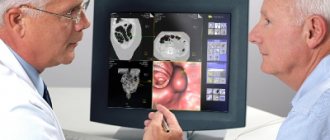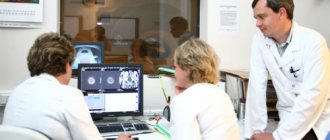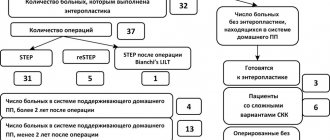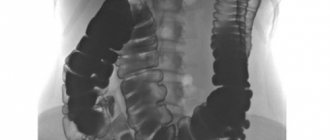4 years ago 8947
- Favorites [x]
- Add to favorites
Thank you, very interesting and clear. memorable.
Thank you, very informative. I would like to see more posts like this.
Thank you. In general, I have also seen such severe ischemic colitis and NSAID colopathy once in my life. And solitary java syndrome, alas, often requires complex differential diagnosis because the ulcer itself is present only in about 30-40% of cases (and can be either single or multiple), and the rest may look like a polypoid formation or simply an area of inflammatory changes in the mucosa. Anamnesis helps in diagnosis - most patients have problems with going to the toilet (the need to strain intensely, etc.) and characteristic biopsy results (The morphological picture is characterized by the replacement of the lamina propria of the mucous membrane with fibroblasts and smooth muscle cells emanating from the muscular plate and located between the crypts.) .
Thanks for the demo! Very clear! Great help in teaching the younger generation)
Thank you, Mikhail Yurievich! Very informative. I look a lot, but I almost never see such a clear pathology. I would probably mistake a solitary ulcer for Crohn's.
Pathological processes affecting the intestines develop gradually and in the initial stages practically do not bother patients. This is why people are often left without adequate medical care until the disease becomes chronic. What symptoms indicate diseases and how to treat an intestinal infection, we will understand together.
Intestinal diseases are a group of inflammatory processes occurring in the large and small intestines. As a result of various negative factors, damage and thinning of the mucous membrane lining the internal organs occurs. Gastroenterologists deal with intestinal problems.
What symptoms may indicate the presence of intestinal diseases?
Statistics say that the main part of all pathological processes in the gastrointestinal tract is associated with the intestines.
But doctors have something to please: many intestinal diseases have been well studied and can be cured. Nowadays, such “mysterious” diagnoses as dysbiosis and IBS (irritable bowel syndrome) are increasingly being made. The attitude of medicine towards these diseases is ambiguous, and treatment methods are controversial. In this article we list the most commonly diagnosed intestinal diseases, symptoms and signs of the disease in each specific case.
Adhesive bowel disease
Adhesions are thin fibrous tissues that form in the abdominal cavity as a result of various negative factors. Adhesive intestinal disease, the symptoms of which are often expressed in the appearance of spasmodic pain, is especially dangerous for humans. The main complaint of patients, as a rule, is chronic abdominal pain, the nature of which is difficult to determine. Sometimes intestinal obstruction, constipation, and disorders are observed. In addition, adhesive intestinal disease, the symptoms of which may be similar to gynecological problems, often becomes the cause of female infertility.
The main symptoms of the disease include discomfort in the navel area, cramps, and a feeling of fullness in the abdomen. In places where adhesions appear, twisting of the intestines occurs, which interferes with the normal movement of its contents. It is possible to develop complete intestinal obstruction. Unfortunately, not many diagnostic methods are able to detect adhesions: they are not visible both on x-rays and ultrasound. They can be seen using barium contrast in CT scans. Treatment of adhesive disease is carried out by laparoscopic surgery or with open surgery by cutting adhesions with a scalpel or electric current.
Intestinal diseases: some anatomy and statistics
To begin with, we will briefly talk about the structure and function of the intestines, and also provide information on epidemiology.
The intestine is represented by two sections: thick and thin. The small intestine, consisting of the duodenum, jejunum and ileum, originates from the pylorus of the stomach and ends at the ileocecal valve. The latter connects the small intestine to the large intestine. The large intestine also has three sections: the cecum, colon and rectum. In the wall of the duodenum (in its submucosa) there are glands whose functions are the secretion of digestive enzymes, hormones, and mucus. The intestines perform vital functions: breaking down food into digestible elements, absorbing nutrients into the blood, removing toxins from the body.
Numerous factors play a role in the occurrence and development of intestinal diseases:
- heredity;
- the presence of other diseases of the digestive system (gastritis, pancreatitis);
- intestinal infections;
- taking certain medications (for example, prolonged and uncontrolled antibacterial therapy can disrupt the composition of the microflora);
- dietary errors (abuse of fatty, fried foods, processed foods, lack of fiber in the diet, etc.);
- lack of vitamins and microelements;
- bad habits;
- excess body weight;
- physical inactivity;
- stress.
Some factors, such as genetic predisposition, are beyond a person's control and cannot be eliminated. Others: nutrition, lifestyle - we are quite able to influence.
Statistics say that certain diseases of the digestive system are present in 90% of the population of developed countries. Thus, inflammatory bowel diseases, which include Crohn's disease and ulcerative colitis, are diagnosed in approximately 200 people out of 100,000 examined. They mainly affect young people. Men and women get sick with approximately the same frequency.
Increasingly, patients with bowel symptoms are being diagnosed with IBS. Its prevalence in the world reaches 20%. According to various sources, women suffer from IBS 2–4 times more often than men, with the highest incidence rates occurring at the age of 30–40 years.
General signs of diseases of the large and small intestines
All symptoms of intestinal diseases can be divided into several groups. The main ones are pain and stool disorders (diarrhea, constipation or a combination of both). Also among the signs of pathologies are flatulence, appetite disorders, the presence of pathological impurities (blood, mucus) in the stool, weight loss and metabolic disorders.
These symptoms are different when different parts of the intestine are affected.
Abdominal pain
Pain syndrome in intestinal pathologies can have a different nature, characteristics, localization, and intensity. Depending on the cause, there is or is no connection between the pain and eating, defecation, etc.
For example, diseases of the small intestine are characterized by quite severe pain around the navel. They may have a pulling, aching character. With spasms, patients experience intestinal colic.
For diseases of the large intestine, dull arching pain in the iliac region (right or left) is typical. They weaken or disappear after defecation and release of gas. There is no clear connection between pain and food intake.
Diarrhea
Indigestion accompanies inflammatory processes in any part of the intestine. We usually talk about diarrhea when the frequency of stool exceeds 3-4 times a day.
Abundant liquid stool is a particularly characteristic symptom of pathologies of the small intestine. Foam and particles of undigested food may be present in the stool.
In pathological processes in the large intestine, liquid feces are observed less frequently, mainly during the period of exacerbation. However, their quantity is small, sometimes traces of blood and mucus are found.
Constipation
Prolonged stool retention is most often a sign of colon disease. Constipation often alternates with diarrhea.
It is important
Constipation is not always caused by intestinal diseases. They are observed in healthy people due to eating disorders, sedentary lifestyle, and side effects of certain medications. In addition, constipation can manifest as disorders of the nervous and endocrine systems.
Flatulence
Increased gas formation and bloating can occur in diseases of any part of the intestine - both large and small, and are also observed in IBS. Symptoms usually worsen in the evening; At night, patients, as a rule, are not bothered by anything.
Exchange disorders
Weight loss, anemia, signs of deficiency of vitamins and microelements (cracks in the corners of the mouth, dry skin, pinpoint hemorrhages) are quite common signs of diseases of the small intestine. Metabolic disorders occur due to poor absorption. One of the symptoms of small intestinal disease in women can be menstrual disorder.
Symptoms of the most common intestinal diseases
According to statistics, inflammatory diseases of the small and large intestines are the most common. They can be acute or chronic.
Enteritis
Enteritis - inflammation of the mucous membrane of the small intestine - is often combined with damage to other parts of the gastrointestinal tract (gastroenteritis, enterocolitis). It occurs in acute or chronic form.
The picture of acute enteritis is typical for food poisoning and some infectious diseases (typhoid fever, cholera, salmonellosis, “intestinal flu”). The disease also occurs due to irritation of the small intestinal mucosa by excessively spicy or rough foods or alcohol.
Acute enteritis first manifests itself as diarrhea, nausea, vomiting, and pain in the umbilical region. Then general symptoms appear: fever, weakness, sweating, headache. The disease progresses quickly.
Chronic enteritis develops over a long period of time, often against the background of concomitant gastritis. The disease manifests itself as dull, low-intensity pain around the navel, nausea, a feeling of bloating, and rumbling after eating. In severe cases, diarrhea is characteristic (stool frequency reaches 20 times a day). Gas bubbles and particles of undigested food are noticeable in the stool. The patient's body weight decreases, weakness, general malaise, and signs of hypovitaminosis (brittle nails, hair loss, dry skin) occur.
Colitis
Inflammation of the mucous membrane of the colon can be isolated or combined with damage to the small intestine and/or stomach (enterocolitis, gastroenterocolitis).
Factors influencing the development of intestinal pathologies
Diseases of the stomach and intestines are caused by the impact of negative factors on the body, and in rare cases, the cause of inflammation is one circumstance. The more different causes simultaneously affecting the human body, the more complex the disease will be and, as a result, the more difficult it will be to treat.
Factors influencing the development of any intestinal pathologies include:
— eating disorders;
- mental stress and stressful situations;
- bacterial intestinal infection;
- alcohol abuse, smoking;
- taking certain medications (for example, antibiotics).
Diseases of the small intestine include enteritis (pathological dysfunction of the small intestine), carbohydrate intolerance, celiac enteropathy (arising due to the lack of necessary enzymes in the body), vascular and allergic diseases of the small intestine, Whipple's disease and others. All of them begin their development due to a violation of the integrity or irritation of the mucous membrane lining the small intestine, due to poor nutrition or taking specific medications.
Diseases of the large intestine include colitis, including ulcerative colitis, Crohn's disease, diverticulosis and other irritations of the colon, tumors and other diseases. Most often, inflammatory processes in this area occur as a result of a bacterial infection, but cases cannot be ruled out when the cause is a long course of antibiotics, malnutrition, etc.
What is
With erythematous gastropathy, hyperemia (redness) of the upper layer of the gastric mucosa occurs. This happens due to inflammatory processes, which usually do not affect the deep layers of tissue, which provoke swelling and blood flow caused by the expansion of capillaries.
Inflammation with gastropathy is usually less pronounced than with true gastritis, and affects only the superficial layers, therefore it is often referred to as superficial gastritis.
It occurs in diffuse and focal forms.
- The focal form is also called erythematous antral gastropathy and is most often found in the antrum of the stomach. It mainly differs in the local nature of the damage, inflammation and swelling are mild.
- Diffuse (common) gastropathy covers a large part of the mucosal surface in different parts. In the absence of adequate treatment, it leads to gastritis and stomach ulcers.
According to the degree of severity, the first and second stages are conventionally divided. They differ in the degree of damage to the epithelium.
Symptoms of colon diseases
Many signs of intestinal diseases are typical and overlap with each other. Characteristic symptoms include dull or cramping abdominal pain, and possible cramps. The inner surface of the large intestine becomes covered with ulcers that may bleed. Patients complain of morning fatigue, defecation with the release of blood and mucus, anemia (with loss of a large amount of blood), and joint pain. Often when the disease occurs, uncontrolled weight loss, loss of appetite, increased body temperature, flatulence, and dehydration occur. Often the patient develops anal fissures.
It is very important that such a colon disease, the symptoms of which can be mistaken for other diseases, is diagnosed in a timely manner. In the absence of adequate treatment, the patient's risk of developing complications (oncology, fistulas, intestinal ruptures and intestinal obstruction) increases.
Causes
Inflammation and erythema of the stomach can be caused by a number of reasons:
- Circulatory disorders.
- Infectious diseases.
- Chemical burns.
- Medicinal (medicinal gastritis).
- Poor nutrition.
- Metabolic disorders due to other pathologies.
- Other irritating factors (smoking, alcohol).
- The daily routine and stress resistance play an important role.
The likelihood of erythematous gastropathy depends on the protective factors of the stomach, the general resistance of the body, and heredity.
Chronic enterocolitis
Chronic enterocolitis is a simultaneous inflammation of both the small and large intestines, which is characterized by atrophy of the mucous membrane lining the inner surface of the intestines, which causes disruption of intestinal functions. Depending on the location of the inflammatory process, the disease is classified for the small (enteritis) and large intestines (colitis) separately.
The causes of chronic enterocolitis are due to the impact on the human body of the following pathological factors:
- long-term malnutrition;
- impaired immunity and metabolism;
- hormonal disorders, stress;
— intoxication with medications and chemicals;
- structural features of the intestine;
— diseases of internal organs;
- intestinal and parasitic infections.
One of the most common pathogens of chronic enterocolitis is intestinal lamblia (photos of these parasites can be seen in the article). They can multiply quickly and cause giardiasis. Signs of the disease include diarrhea, excess gas, abdominal cramps and pain, nausea, and vomiting. Giardia, the photo of which is presented in the picture, exists in two forms: active and inactive. Active forms of parasites live in the human body; when released along with feces, they turn into an inactive form and spread the infection outside the body.
Chronic enterocolitis often results from untimely or poor-quality treatment of acute forms of inflammatory bowel processes. In addition, there is a risk of transmission of the disease by inheritance and in people who were bottle-fed in infancy.
Symptoms
Since gastropathy is an inflammation, it is accompanied by typical symptoms of digestive disorders:
- Heaviness in the hypochondrium.
- Epigastric pain.
- Belching air.
- Nausea and vomiting after eating.
- Permanent white coating on the tongue.
At the initial stages it is completely asymptomatic, then either goes away on its own (if the provoking factors had a short-term effect), or worsens and passes into the second, more dangerous stage.
Treatment
In order to properly treat gastropathy, before starting therapy, the factors that caused hyperemia are determined; these can be various medications or constant poor nutrition. The faster the cause is eliminated, the faster the recovery will come.
An important point in treatment is the detection of concomitant diseases, they are often chronic or erosive gastritis, gastroduodenitis, GERD.
Medicines
If it is determined that the cause of gastropathy is the medications you are taking, it is advisable to ask your doctor to change them. If this is not possible in this situation, medications are used to protect the stomach from harmful factors.
Medicines that can be prescribed for erythematous gastropathy:
Feel free to understand the problem that interests you together. >>>
- Antisecretory (Omeprazole, Nolpaza, Kvametel, Pariet). Reduce the production of the main irritant of the mucous membrane - hydrochloric acid.
- Gastroprotectors (De-nol, Vikair, Vikalin). Due to the bismuth contained in the composition, they have an astringent and anti-inflammatory effect, protecting the walls of the organ. Helps fight bacteria that cause stomach ulcers.
- Antacids (Almagel, Maalox, Gastal). Reduce acidity, therefore, the aggressiveness of the stomach environment. Binds and removes pathogenic substances.
- Regulating motor skills (Ganaton, Itopride). Can be prescribed in case of stagnation in the stomach and subsequent fermentation and rotting.
Comprehensive treatment with folk remedies gives good results. Herbs are used: gastric herbs, chamomile, fennel. They are mainly aimed at mildly relieving inflammation and improving digestion. Flax seeds and oat jelly are used as an enveloping, stomach-protecting home remedy.
You need to be especially careful with drugs from the NSAID group; due to their ulcerogenic effect, they often cause stomach pathologies.
Nutrition
Proper nutrition remains an important component of treatment. Products that irritate the mucous membrane are excluded: sour, spicy, salty, smoked, fried, soda, alcohol, coffee and others. It is recommended to cook in a double boiler and pay more attention to dishes such as porridge, jelly, and broth. Eating hot or cold food is contraindicated.
Colopathy
Colopathy is a type of pathology of the colon mucosa, in which non-inflammatory changes are dominant. In most cases, these changes develop secondary, against the background of diseases, usually not related to the colon. Most often, colopathies are observed with systemic lesions, renal failure, liver cirrhosis, poisoning with heavy metal salts, and allergic reactions of the body. Based on the nature of macroscopic changes, the following types of colopathy are distinguished: 1. Hemorrhagic colopathy, in which, against the background of a visually unchanged mucous membrane with a normal or moderately enhanced vascular pattern, single or multiple small-point subepithelial hemorrhages are detected. Pathogenetically spontaneous or contact hemorrhages can form either when the permeability of the capillary wall is impaired, or when the rheological properties of the blood change. 2. Congestive (congestive) colopathy, in which, against the background of a visually unchanged mucous membrane, there is a significant dilation of the vessels of the submucosa (usually venous trunks), the diameter of which can be 1 cm or more. Typical congestive vascular colopathy of the distal colon, caused by a sharp increase in pressure in the portal venous system, is observed in liver cirrhosis (Kozarek RA et. al, 1991). 3. Erosive colopathy (acute erosion), in which single or multiple surface defects of the mucous membrane of a regular shape are identified, the size of which does not exceed 1 cm. As a rule, ulcerations have a “stamped appearance”, are discrete and are located against the background of an unchanged mucous membrane. In some cases, a halo of hyperemia is visualized around the erosions. Acute destructive changes in the mucous membrane of the colon are observed with impaired renal function (uremia), liver, the use of certain medications, as well as with allergic conditions of the body, ischemic damage to the intestinal wall and after hemodialysis. Despite the variety of causes that cause destructive forms of colopathy, their development, as a rule, is based on either a cytotoxic or vascular factor, or a combination of both. 4. Ulcerative colopathy (acute ulcers), in which single deep round-shaped defects of various sizes are usually found. They are surrounded by unchanged mucous membrane. In most cases, acute ulcers accompany such severe conditions of the body as sepsis, hemorrhagic shock, burn disease, and surgical trauma. 5. Mixed colopathy is characterized by polymorphism of endoscopic signs (hemorrhages, erosions, ulcers). The most common is the erosive-hemorrhagic type of colopathy, which develops against the background of the use of non-steroidal anti-inflammatory drugs, hemodialysis, and acute poisoning with heavy metal salts. As a rule, acute erosions and ulcers are accompanied by bleeding of varying degrees of severity (Doletsky S.Ya. et al., 1984; Sivak M., 2000). With colopathy, changes in the mucous membrane are usually diffuse (total) in nature. However, in some cases, their extent may be limited to damage to one or more segments of the colon
© 2022 — Federal State Budgetary Institution “Clinical Hospital No. 1” (Volynskaya) of the Administration of the President of the Russian Federation. The use of materials is permitted only if a link to the website volynka.ru is provided. The site is for informational purposes only and under no circumstances is it a public offer as defined by the provisions of Article 437 (clause 2) of the Civil Code of the Russian Federation. License FS-99-01-009652 dated 06/11/2019. Issued by the Federal Service for Surveillance in Healthcare. No expiration date.
Sign up for specialists and research
All that remains is to fill out the application.
Advice:
you can make an appointment with several doctors at once!
To save time and visit several doctors in one day, continue choosing specialists and diagnostic tests, and then fill out a general request for an appointment.
Characteristic
Erythematous gastroduodenopathy is an overflow of blood vessels on the inner surface of the stomach walls. Pathology usually affects only the outer layer, without reaching the deeper levels. It is detected using fibrogastroduodenoscopy (FGDS). This study is carried out using a special device in the form of a hose, equipped with a camera and a lighting apparatus. The procedure is carried out only on an empty stomach.
The areas affected by the device are first treated with an anesthetic. The probe is swallowed, and within a few minutes the device records the condition of all areas of the stomach cavity, esophagus, and duodenum. In addition to visible disorders, endoscopy determines the acidity of the affected organ and the presence of dangerous bacteria.
Causes
The appearance of erythematous gastropathy is caused by many factors. Alcoholics, smokers, and carriers of chronic gastrointestinal diseases are at risk. The reasons for the appearance of lesions are as follows:
- heredity;
- poor nutrition;
- constant stress;
- the presence or entry into the stomach of infections (fungal or Helicobacter pylori). If foreign pathogens are detected, the patient is prescribed additional tests, for example, a blood test;
- disruption of metabolic processes in the body;
- the presence of diseases of the gastrointestinal tract (gastritis, pancreatitis, cholecystitis).
Identifying the causative agent of gastropathy will help prescribe the proper treatment.
Erythematous gastroduodenopathy varies in forms of manifestation and in the degree of the inflammatory process. The first criterion evaluates the territorial distribution of the area of redness; they are of two types:
- the focal form implies local lesions occupying separate small parts of the upper layers of the stomach. This is the safest type of phenomenon. It occurs with minor deviations in the diet, and rarely results in an independent diagnosis of gastritis. May be caused by a reaction to medications;
- diffuse type (common) is characterized by damage to large areas of the stomach. Redness and swelling can simultaneously affect several parts of the organ. The advanced form progresses to gastritis and can cause additional stomach problems. There is a possibility that the resulting lesions appeared after consuming heavy irritating food or alcohol on the eve of the examination.
Treatment of focal erythematous gastropathy is much faster and does not pose any danger. The common form transforms when symptoms are ignored.
The disease is classified into two degrees of inflammation. The characteristic is determined by monitoring the condition of the surface layer of the mucosa and the stage of impact on the lining of the stomach. The first degree of inflammation is the primary manifestation of deformation of the integument of the organ under study. The second stage indicates the development of the process. This means that the stomach continues to be influenced by external, provoking factors.
Diagnosis of intestinal diseases
Inflammatory bowel disease should only be diagnosed after other possible problems have been ruled out. This will require a combination of diagnostic tests. Diagnosis of intestinal diseases includes the following tests and procedures:
- Blood test - it is necessary to monitor hemoglobin levels.
- Analysis of stool to detect blood in it.
- Colonoscopy - allows you to view the entire rectum using a thin flexible tube with a camera connected to it. During the procedure, the doctor may take tissue samples for additional analysis (biopsy).
— Flexible sigmoidoscopy – is performed using a thin flexible tube with a light sensor, which allows you to examine the sigmoid portion of the colon.
— Upper endoscopy—the doctor uses a thin, flexible, lighted tube to examine the esophagus, stomach, and first part of the small intestine.
— Capsular endoscopy – performed to diagnose Crohn’s disease.
- X-ray diagnostics - necessary for serious problems with the intestines, in order to exclude serious complications (for example, perforation of the colon).
- Computed tomography - this method allows you to see more different details in the image than with an x-ray. The test evaluates the entire intestine, as well as tissues outside of it.
— Magnetic resonance imaging is a particularly effective method for excluding fistulas, ruptures and other complications.
Other types of gastropathy
In addition to erythematous, there are other types of gastropathy that take a more serious turn. They are all characterized by lesions of various categories and areas of the gastric mucosa. Each type is capable of developing into a more severe form.
Antral
Gastropathy of the antrum affects the lower region of the stomach, which is responsible for breaking down digested food. The disease slows down the passage of food into the duodenum. Difficulty in movement causes congestion. Characteristic erythema appears in the antrum of the stomach. Most often, lesions in this area have a focal form. We also recommend that you read: diet for antral gastritis.
Gastropathy of the antrum of the stomach often accompanies chronic inflammatory processes of the diseased organ. Symptoms and identification of lesions mimic other diseases of the gastrointestinal tract. Diagnosis of gastropathy affects only the areas of the superficial antrum.
Ignoring the symptoms of damage leads to deeper inflammation, leading to serious illnesses. It is easy to imagine what antral gastritis is by studying gastropathy of the lower stomach. The symptoms are similar, but studying the nature of the inflammation is different.
Antral gastropathy or gastritis against the background of mucosal atrophy is detected in the later stages. The patient did not come for examination on time, the lesions progressed.
Erythematous gastroduodenopathy, when neglected, leads to bleeding and ulcers. Gastritis with atrophy of the gastric mucosa is already a sign of a precancerous condition.
Papular
The localization of papular gastropathy usually affects the antrum of the stomach. Its characteristic feature is the formation of erosive lesions. They are called papules and are not dangerous. Affects the superficial layers of the gastric mucosa. Appears mainly due to increased production of hydrochloric acid and cardia insufficiency.
Stagnant
One of the common types is congestive gastroduodenopathy. Signs of damage are manifested by erosive and ulcerative wounds on the surface of the gastric mucosa. The protective functions of the diseased organ in the stagnant form are weakened, the blood supply is deteriorated.
There are no painful symptoms, the disease manifests itself in the form of belching, nausea, bloating, and discomfort after eating. It develops in conjunction with other diseases of the gastrointestinal tract (liver, pancreas). Indicates the presence of problems in the gastrointestinal tract.
Erosive
A form of gastropathy in which the lesions have the appearance of lumpy inflammation. The tip of the damage is concave. It has acute and chronic forms. The sizes of erosions of erythematous gastroduodenopathy range from 2 to 7 mm. The lesion often causes exudative gastritis (superficial). It is easily confused with erosive gastropathy due to mild inflammation and the absence of clear symptoms.
Any form of gastropathy can be accompanied by erythematous bulbitis. It is provoked by eating disorders and gastritis. The lesion causes a more dangerous form of inflammation - erosive.
Erythematous bulbopathy is a bright red, oval-shaped inflammation that affects the lower stomach and upper duodenum. The disease develops very slowly, progressing for years in the latent stage.
Treatment
The onset of erythematous gastropathy of various forms can cause serious damage to the gastrointestinal tract, leading to a chronic form. Potential complications include: gastritis, gastroduodenitis, peptic ulcer, cholecystitis. Relying only on self-medication is dangerous. The slightest signs of stomach problems require consultation with a specialist. He will tell you how to properly treat gastroduodenopathy.
Getting rid of the disease depends on the form, type, and cause of the lesion. Methods for treating inflammation of the gastric mucosa are:
- restorative nutrition - diet 5;
- folk remedies;
- taking medications.
Diet
Spicy, fatty, smoked, fried foods are excluded from the diet. Prohibition of alcoholic beverages and tobacco products. The diet involves split meals in small portions. The intervals between meals are two to three hours. If the cause of the lesions is a malnutrition, following this diet will quickly relieve the signs of gastropathy. Symptoms and treatment are easily determined in the absence of other pathogens.
It is important to know! The focal form, usually caused by poor diet, resolves within a week.
Medicines
The nature of the course of inflammatory lesions determines effective medications. Each case requires a specific approach:
- increased acidity - medications are prescribed that lower its level, coat the walls of the stomach, antacids;
- the presence of pathogenic microorganisms requires the inclusion of antibiotics;
- low acidity requires drugs that regulate the action of motility of the gastrointestinal tract;
- Acute, advanced cases are accompanied by pain syndromes, and drugs that block them are prescribed.
Folk remedies
Diet and medication are the most common way to combat erythematous gastropathy. Treatment with folk remedies is preventive in nature and is used as part of complex therapy. However, natural components cope well with mild inflammatory processes.
Decoctions and tinctures based on herbs have become widespread: chamomile, calendula, St. John's wort, thyme. Popular products include sea buckthorn, oak bark, cabbage juice, and honey.
Surgery is rarely used for mucosal hyperemia. Surgery is prescribed only for bleeding, when drug treatment is powerless.
Treatment of intestinal diseases
To effectively heal intestinal diseases, symptoms and treatment must be closely related. The goal of treating inflammatory bowel disease is to reduce the inflammation that causes symptoms and discomfort. Adequate therapy will not only alleviate the manifestation of the disease, but will also lead to long-term remission and reduce the risk of complications. Before treating an intestinal infection, the doctor conducts a thorough diagnosis, which will allow you to choose the most effective methods of therapy.
Treatment can be carried out using medication, folk and surgical methods. Medicines can relieve symptoms and reduce the risk of complications. It should be said right away that many patients will be forced to take drug treatment for an extended period of time. The choice of medications depends on the location of the inflammation, the severity of the symptoms of the disease and will be aimed at preventing relapse of the disease. Sometimes it may be necessary to combine medications, supplementing drug therapy with traditional recipes.
The following categories of drugs are used to treat intestinal infections and inflammatory processes:
- anti-inflammatory drugs (aminosalicitals, corticosteroids);
- antibacterial drugs (for example, Ciprofloxacin);
— immunomodulators (drugs “Methotrexate”, “Azathioprine”);
- disease-modifying agents (drugs Infliximab, Adalimumab).
Treatment with medications should be accompanied by changes in diet, stress reduction, and adherence to a rest regime. A very important stage of treatment is that patients follow a diet for intestinal disease. The diet should consist of healthy, balanced foods with sufficient protein and nutrients. The diet is selected individually for each specific patient. General recommendations regarding proper nutrition include the following:
- eat small portions throughout the day;
- drink a lot of clean water (up to 2 liters in small portions, evenly distributed throughout the day);
- avoid foods high in fiber (legumes, nuts, bran);
- Avoid fatty and fried foods, sauces, and foods that cause bloating;
- limit dairy products (if lactose intolerant);
— during treatment it is important to take vitamins B12, D, calcium, and iron supplements.









